病理学-传染病与寄生虫病
N2020008《病理学》教学大纲(56学时)

《病理学》课程教学大纲课程名称:病理学课程编号: N2020008英文名称: Pathology课程性质: 必修课总学时: 56 讲课学时:47 实验学时:9学分:3.5适用对象: 中医学、中医学(5+3一体化)、中医学(5+3一体化)修园班先修课程:生物学、解剖学、组织胚胎学、生理学、生物化学、微生物学、寄生虫学一、课程性质、目的和任务病理学是研究疾病发生、发展和转归规律,阐明疾病本质的医学基础理论学科。
主要侧重从形态学角度研究疾病,为基础医学与临床医学之间的桥梁学科。
中医专业开设病理学课程,目的是不仅可以引导学生从现代医学角度对患病机体的病理变化有一个完整的动态认识,同时也可以为学生今后从事中医药学的诊疗和研究奠定必要的病理学基础知识和理论。
病理学的主要任务是研究疾病的病因、发病机制、机体在疾病过程中形态结构、机能和代谢的改变和转归,从而认识疾病的本质,为防治疾病提供必要的理论基础和实践依据。
二、课程教学和教改基本要求病理学的教学内容包括理论和实验两部分。
理论教学内容又分为总论和各论。
总论主要学习不同疾病的共同的基本规律,各论主要学习各系统疾病的特殊规律。
理论教学应重视病理形态变化与功能代谢、临床表现的联系,重视病变局部与整体的联系,适当联系疾病的防治,适当介绍国内外病理学新进展。
实验教学要求学会观察大体标本和组织切片病理变化的方法,并能应用病理学知识综合分析病理学变化,能对所学疾病的病理变化与临床病理联系进行独立分析、作出初步结论。
病理学的教改基本要求是在教学方法上要注重启发式教学,充分发挥学生在学习上的主动性、目的性和创造性,培养学生的独立自学、科学思维以及分析问题和解决问题的能力。
三、课程各章重点与难点、教学要求与教学内容绪论【教学要求】了解病理学的内容、任务及其在医学中的地位。
【教学内容】1. 病理学的内容和任务。
2. 病理学在医学中的地位。
3. 病理学的研究方法。
4. 病理学观察方法和新技术的应用。
传染病与寄生虫病
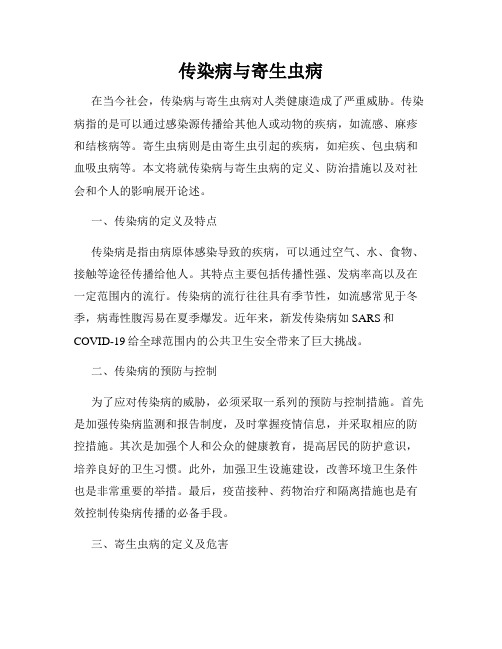
传染病与寄生虫病在当今社会,传染病与寄生虫病对人类健康造成了严重威胁。
传染病指的是可以通过感染源传播给其他人或动物的疾病,如流感、麻疹和结核病等。
寄生虫病则是由寄生虫引起的疾病,如疟疾、包虫病和血吸虫病等。
本文将就传染病与寄生虫病的定义、防治措施以及对社会和个人的影响展开论述。
一、传染病的定义及特点传染病是指由病原体感染导致的疾病,可以通过空气、水、食物、接触等途径传播给他人。
其特点主要包括传播性强、发病率高以及在一定范围内的流行。
传染病的流行往往具有季节性,如流感常见于冬季,病毒性腹泻易在夏季爆发。
近年来,新发传染病如SARS和COVID-19给全球范围内的公共卫生安全带来了巨大挑战。
二、传染病的预防与控制为了应对传染病的威胁,必须采取一系列的预防与控制措施。
首先是加强传染病监测和报告制度,及时掌握疫情信息,并采取相应的防控措施。
其次是加强个人和公众的健康教育,提高居民的防护意识,培养良好的卫生习惯。
此外,加强卫生设施建设,改善环境卫生条件也是非常重要的举措。
最后,疫苗接种、药物治疗和隔离措施也是有效控制传染病传播的必备手段。
三、寄生虫病的定义及危害与传染病类似,寄生虫病也是一种影响人类健康的重要疾病。
寄生虫通过寄生在人体内或外,从而获得养分和生存环境。
常见的寄生虫病包括疟疾、钩虫病和蛔虫病等。
寄生虫会危害人体的消化系统、呼吸系统以及神经系统,严重时可能导致贫血、营养不良和智力发育受损等问题。
四、寄生虫病的防治策略为了遏制寄生虫病传播,应采取综合的防治策略。
首先,重视环境卫生和个人卫生,加强家庭和公共场所的清洁和消毒工作。
其次,大力推广卫生教育,普及有关寄生虫病的预防知识,提高个人和公众的自我保护意识。
此外,科学合理地进行药物治疗也是防治寄生虫病的重要手段。
针对不同的寄生虫病,还需要开展对应的疫苗研发和接种工作。
五、传染病与寄生虫病对社会和个人的影响传染病和寄生虫病给社会和个人带来了巨大的健康负担和经济损失。
传染病与寄生虫病
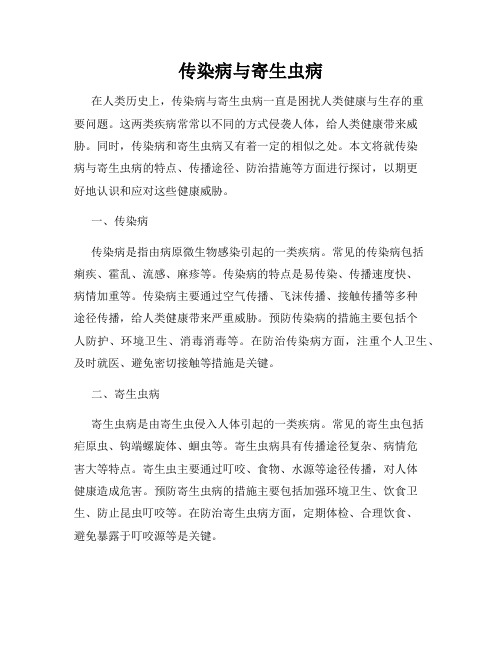
传染病与寄生虫病在人类历史上,传染病与寄生虫病一直是困扰人类健康与生存的重要问题。
这两类疾病常常以不同的方式侵袭人体,给人类健康带来威胁。
同时,传染病和寄生虫病又有着一定的相似之处。
本文将就传染病与寄生虫病的特点、传播途径、防治措施等方面进行探讨,以期更好地认识和应对这些健康威胁。
一、传染病传染病是指由病原微生物感染引起的一类疾病。
常见的传染病包括痢疾、霍乱、流感、麻疹等。
传染病的特点是易传染、传播速度快、病情加重等。
传染病主要通过空气传播、飞沫传播、接触传播等多种途径传播,给人类健康带来严重威胁。
预防传染病的措施主要包括个人防护、环境卫生、消毒消毒等。
在防治传染病方面,注重个人卫生、及时就医、避免密切接触等措施是关键。
二、寄生虫病寄生虫病是由寄生虫侵入人体引起的一类疾病。
常见的寄生虫包括疟原虫、钩端螺旋体、蛔虫等。
寄生虫病具有传播途径复杂、病情危害大等特点。
寄生虫主要通过叮咬、食物、水源等途径传播,对人体健康造成危害。
预防寄生虫病的措施主要包括加强环境卫生、饮食卫生、防止昆虫叮咬等。
在防治寄生虫病方面,定期体检、合理饮食、避免暴露于叮咬源等是关键。
通过对传染病与寄生虫病的了解,我们可以更好地预防和控制这些疾病的传播,保障人类健康。
我们应该注重个人卫生、加强环境卫生、科学饮食、加强公共卫生等措施,共同抵御传染病和寄生虫病的威胁。
希望通过我们的努力,传染病和寄生虫病可以得到有效控制,人类健康可以得到更好地保护。
《传染病与寄生虫病病理学彩色图谱》

《传染病与寄生虫病病理学彩色图谱》作者:郭瑞珍来源:《全国新书目》2013年第10期本专著是贵州省遵义医学院的一批长期从事临床病理学和相关专业医学教学的专家合著,记录了作者多年来从事病理诊断工作中所见到的部分传染病和寄生虫病的素材。
全书共50万字,分为9个章节,系作者们从几十年临床病理工作中积累的珍贵标本和照片中精选资料,依照病原体的分类学为依据,将涉及到的我国常见的42种人体传染病和寄生虫病系统地逐一介绍。
作为图谱,共提供了精美的图片共583幅,其中包括组织病理学图片419幅、大体标本照片94幅、细胞学涂片20幅、模式绘图5幅、影像图2幅、特殊染色图29幅、免疫组织化学染色图7幅以及组织压片5幅和原位杂交图2幅等。
作者简介:郭瑞珍,女,1951年10月出生,中共党员,病理学教授,硕士研究生导师。
从事病理学专业30余年,以病理学教学、科研和临床诊断为一体,先后承担并完成省、厅级课题多项,先后获省科技进步二等、三等奖和厅一等奖多项;主编高校教材1部,主编或参编专著4部;发表科研论文70余篇;培养硕士生13人。
2007年获贵州省“优秀教师”称号。
传染病、寄生虫病一直是严重危害人类健康的高发疾病,其病种之多,涵盖内容之广,已经成为日常病理诊断中的重要内容。
在一些古老的疾病被不断消灭的同时,新的传染病也在不断滋生,有的传染病甚至死灰复燃,继续危害人类身体健康。
然而,随着岁月的流逝,有些传染病、寄生虫病的素材逐渐从病理人的视线中淡化或消失;而一些相继出现的传染病、寄生虫病的素材,却又较少系统地出现在病理人的视线中。
作者从事病理工作的30余年中,感觉到在临床外检方面很需要一本较完整、系统的传染病、寄生虫病病理诊断参考书,以解除临床病理医生诊断上的困惑,满足病理后继人的希望。
本书把传染病、寄生虫病的基本理论、基本病变和临床实践知识相结合,把病理学知识和传染病、寄生虫病的相关学科知识(寄生虫学、微生物学、传染病学)相结合,以求较全面地认识传染病、寄生虫病,并作出诊断和鉴别诊断。
疾病学基础 第十八章 传染病与寄生虫病

二、肺结核病
(一)继发性肺结核病
3.慢性纤维空洞型肺结核
• 开放型肺结核
• 病变特点: 多在肺上叶可见一个或多个厚壁 空洞,肺下叶可见由支气管播散引起 的新旧不一、大小不等、病变类型不 同的病灶,部位越下越新鲜。
第一节 结核病
第 二节
第三节
第四节
第五节
第六节
第八节
二、肺结核病
(一)继发性肺结核病
第一节 结核病
第 二节
第三节
第四节
第五节
第六节
第八节
二、肺结核病
(一)继发性肺结核病
1.局灶型肺结核
• 早期病变,属于无活动性肺结病。 • 病变特点:位于肺尖,病灶较小,
境界清楚,增生为主。
• 临床表现:无明显自觉症状。
• 结局:自愈或发展成浸润型肺结核。
第一节 结核病
第 二节
第三节
第四节
第五节
第六节
3.慢性纤维空洞型肺结核
镜下空洞壁分三层: 内 层 中 层
内层—干酪样坏死层
中层—结核性肉芽组织 外层—增生的纤维组织
外 层
第一节 结核病 第 二节 第三节 第四节 第五节 第六节 第八节
二、肺结核病
(一)继发性肺结核病
3.慢性纤维空洞型肺结核
痰中带菌(重要的传染源),需隔离。 病情时轻时重,反复多样。 侵蚀血管,咯血。 可引起喉结核,肠结核。 后期肺组织广泛纤维化,可至肺源性心脏病。
干酪样坏死物
第一节 结核病
第 二节
第三节
第四节
第五节
第六节
第八节
一、概述
3.转归
转向愈合: 吸收消散 纤维化、纤维包裹及钙化
转向恶化:
《病理学传染病》课件

器官组织的损伤
传染病会导致器官组织损 伤,引起相应的病理变化 ,如炎症、坏死、出血等 。
免疫病理损伤
传染病的免疫病理变化包 括超敏反应和自身免疫病 等,可引起机体组织损伤 和功能障碍。
并发症
传染病的并发症包括继发 感染、多器官功能衰竭等 ,可加重病情和增加治疗 难度。
03
常见传染病病理学特点
流感
《病理学传染病》PPT课件
目录
• 病理学传染病概述 • 传染病病理学基础 • 常见传染病病理学特点 • 传染病预防与控制 • 传染病研究进展
01病理学传染病概述Fra bibliotek定义与分类
定义
传染病是由病原体(细菌、病毒 、真菌等)引起的,能在人与人 、动物与动物或人与动物之间相 互传播的一类疾病。
分类
根据病原体的不同,传染病可分 为细菌性传染病、病毒性传染病 、寄生虫性传染病等。
药物治疗的进步不仅提高了治愈 率,降低了病死率,同时也改善 了患者的生活质量,减轻了疾病
负担。
传染病疫苗的研究进展
疫苗是预防传染病的有效手段之一, 近年来在疫苗研发方面也取得了显著 进展。
疫苗的研发和应用对于预防和控制传 染病具有重要意义,尤其在控制疫情 爆发和降低发病率方面发挥了重要作 用。
一些新疫苗不断问世,如针对埃博拉 出血热、寨卡病毒等疾病的疫苗,以 及针对流感病毒的新型流感疫苗等。
肝炎
肝炎概述
肝炎是由肝炎病毒引起的肝脏 炎症,具有传染性。肝炎病毒 有多种类型,如甲型、乙型、
丙型等。
病理学特点
肝炎病毒主要攻击肝脏细胞, 导致肝脏细胞坏死和炎症反应 。长期肝炎可引起肝硬化和肝 癌。
并发症
肝炎并发症严重,可引起消化 道出血、肝性脑病等,甚至可 能导致死亡。
第三章病理学:常见传染病及寄生虫病测考试题.doc

第三章病理学:常见传染病及寄生虫病测考试题考试时间:120分钟 考试总分:100分遵守考场纪律,维护知识尊严,杜绝违纪行为,确保考试结果公正。
1、单项选择题在结核结节中最具有诊断意义的细胞成分是哪种细胞( )A.朗格汉斯巨细胞和淋巴细胞B.朗格汉斯巨细胞和上皮样细胞C.异物巨细胞和成纤维细胞D.上皮样细 胞和异物巨细胞E.朗格汉斯巨细胞和巨细胞 本题答案:B 本题解析:暂无解析 2、单项选择题关于浸润型肺结核的叙述正确的是( )A.临床上最常见的类型 B.属于非活动性肺结核 C.肺门淋巴结结核 D.病人常无明显临床症状 E.痰中结核菌常为阴性 本题答案:A 本题解lC.液化性坏死 D.纤维样坏死 E.凝固性坏死 本题答案:B 本题解析:暂无解析姓名:________________ 班级:________________ 学号:________________--------------------密----------------------------------封 ----------------------------------------------线----------------------6、单项选择题人体消灭结核杆菌主要依靠的细胞是()A.中性粒细胞B.嗜酸性粒细胞C.浆细胞D.B淋巴细胞E.巨噬细胞本题答案:E本题解析:暂无解析7、单项选择题关于淋病的特点,错误的叙述是()A.易侵袭黏膜B.以性传播为主C.病原体为革兰阴性双球菌D.感染最早期表现为阴道炎E.是世界上发病率最高的性传播疾病本题答案:A本题解析:暂无解析8、单项选择题患儿4岁,头痛、发热,神志不清,抽搐不止,体检:颈软,四肢及躯干见大片淤斑。
尸检:脾肿大,刀刮有脾泥,肾上腺大片出血,脑膜充血、混浊,在脑膜血管周围有少量中性粒细胞浸润。
应诊断为()A.结核性脑膜炎B.暴发型流行性脑脊髓膜炎C.流行性出血热D.普通型流行性脑脊髓膜炎E.化脓性脑膜脑炎本题答案:B本题解析:暂无解析9、单项选择题成为重要传染源的肺结核病是()A.结核球B.局灶型肺结核C.支气管内结核D.慢性纤维空洞型肺结核E.浸润型肺结核本题答案:D本题解析:暂无解析10、单项选择题血吸虫病对人体造成的危害主要是()A.成虫B.虫卵C.毛蚴D.尾蚴E.童虫本题答案:B本题解析:暂无解析11、判断题在非工作帮上的平台,按其用途分为安全平台、运输平台和清扫平台。
病理学传染病

病理学传染病传染病是由病原体引起的,能在人与人、动物与动物或人与动物之间相互传播的一类疾病。
病原体中大部分是微生物,小部分为寄生虫,寄生虫引起者又称寄生虫病。
有些传染病,防疫部门必须及时掌握其流行规律,采取措施,制止其蔓延,这类疾病称为法定传染病。
传染病的传播和流行必须具备3个环节即传染源、传播途径及易感人群:传染源是指病原体已在体内生长繁殖并能将其排出体外的人和动物。
传播途径是指病原体离开传染源到达另一个易感者的途径。
主要包括以下几种:(1)呼吸道传播:病原体存在于空气的飞沫或气溶胶中,易感者吸入后导致感染,如麻疹、白喉、流行性感冒等。
(2)消化道传播:病原体污染食物、水源后,易感者误食后感染,如伤寒、细菌性痢疾等。
(3)接触传播:易感者与疫源直接接触后导致感染或感染可能性增加,如手、眼、生殖器等部位有疫源接触史,直接接触疫源被感染。
还包括母婴传播、血液或血制品传播、虫媒传播、器官移植和医务人员职业暴露等传播途径。
易感人群是指对某种传染病缺乏特异性免疫的人。
传染病的预防主要在于控制传染源、切断传播途径及增强免疫力等方面。
一旦发现疫情应该立即采取隔离和上报疫情,并对疫区进行严格的封锁和消毒处理。
对于一些常见的传染病如流感、手足口病等,我们可以采取接种疫苗来增强免疫力,并保持良好的个人卫生习惯。
病理学是医学科学中的一门基础学科,主要研究疾病的病因、病理变化和转归,以及病理学与临床诊断、治疗和预防之间的关系。
病理学复习资料包括各种疾病的基本概念、病因、病理变化、病理生理机制、诊断方法和治疗原则等方面。
系统学习:建议按照教材的章节顺序进行学习,逐步掌握每个章节中的知识点。
重点突出:根据考试大纲和实际需要,将重点知识点进行标注,加强记忆。
实际:将病理学知识与临床实践起来,加深对疾病的认识和理解。
多做练习:通过做题等方式进行知识点的巩固和复习,提高解题能力。
归纳总结:在学习过程中不断进行知识点的归纳和总结,形成自己的知识体系。
在职同等学力考研西医综合(病理学-传染病及寄生虫病)模拟试卷2(

在职同等学力考研西医综合(病理学-传染病及寄生虫病)模拟试卷2(题后含答案及解析)题型有:1. B1型题 2. A1型题 3. X型题A.噬神经细胞现象B.陷窝细胞C.上皮样细胞D.泡沫细胞1.动脉粥样硬化症可见A.B.C.D.正确答案:D 涉及知识点:传染病及寄生虫病2.乙型脑炎可见A.B.C.D.正确答案:A解析:动脉粥样硬化的脂纹期、斑块期的病灶均可见到泡沫细胞。
流行性乙型脑炎可见到噬神经现象。
陷窝细胞见于结节硬化型霍奇金淋巴瘤。
知识模块:传染病及寄生虫病3.不符合流行性脑脊髓膜炎的描述是A.引起脑膜刺激征B.引起颅内压升高症状C.引起脑脊液浑浊或脓样D.引起神经细胞变性坏死正确答案:D解析:严重流行性脑脊髓膜炎病例可累及临近脑膜的脑实质,使神经元变性,称脑膜脑炎。
知识模块:传染病及寄生虫病4.流行性乙型脑炎的主要病理变化是A.神经细胞变性坏死B.蛛网膜下腔积脓C.肉芽肿形成D.脑疝形成正确答案:A解析:流行性乙型脑炎的病变广泛累及脑脊髓实质,引起神经细胞变性、坏死,胶质细胞增生和血管周围炎细胞浸润。
知识模块:传染病及寄生虫病5.原发性肺结核病的肺内原发灶常位于A.肺尖B.肺上叶下部或肺下叶上部靠近胸膜处C.肺门D.肺背侧正确答案:B解析:原发性肺结核病最初在通气较好的肺上叶下部或下叶上部近胸膜处形成1~1.5cm大小的灰白色炎性实变灶(Ghon灶),绝大多数病例病灶中央有干酪样坏死。
知识模块:传染病及寄生虫病6.不符合浸润型结核病的描述是A.属于无活动性肺结核B.常发生干酪样坏死C.可引起干酪样肺炎D.可经纤维化、钙化痊愈正确答案:A解析:浸润型结核病是最常见的成人型继发性肺结核,属活动性肺结核,以渗出病变为主,中央为干酪样坏死,周围为广泛的炎细胞包绕。
临床中毒症状明显。
知识模块:传染病及寄生虫病7.不符合结核性胸膜炎的描述是A.可由继发性肺结核引起B.可由原发性肺结核引起C.多为渗出性胸膜炎D.多为增生性胸膜炎正确答案:D解析:渗出性胸膜炎属浆液性纤维素性炎,可形成胸腔积液,以后吸收机化发生胸膜增厚和粘连。
传染病与寄生虫病学备考资料

传染病与寄生虫病学名称病原传染源传播途径易感人群流行特征临床表现潜伏期隔离期接触者检疫及处理备注腺鼠疫鼠疫耶尔森菌鼠类(黄鼠属和旱獭)动物和人间鼠疫传播(病鼠-蚤-人)经皮传播普遍易感夏秋季突然发热、高热、白细胞剧增、淋巴结肿大(腹股沟、腋下、颈部及颌下)、淋巴结及其周围组织显著红肿热痛并与组织粘连成块,剧烈触痛。
2-4天隔离至肿大的淋巴结消退,鼠疫败血症症状消失后培养3次(每隔3天)阴性接触者检疫9可服四环素或磺胺嘧啶SD预防,发病地区进行疫区检疫云南西部黄胸鼠疫源地和青藏高原喜马拉雅旱獭疫源地;败血症鼠疫因皮肤广泛出血、瘀斑、发绀、坏死,死后尸体呈紫黑色,俗称黑死病;荧光抗体发FA可快速准确诊断;治疗可用链霉素。
肺鼠疫鼠疫耶尔森菌鼠类(黄鼠属和旱獭)、肺鼠疫病人呼吸道飞沫传播普遍易感夏秋季寒战高热、剧烈胸痛、咳嗽、咳大量泡沫血痰,呼吸急促或困难和发绀,肺部湿罗音或摩擦音,X线支气管肺炎症状。
1-3天就地隔离至症状消失后痰培养连续6次阴性接触者检疫9可服四环素或磺胺嘧啶SD预防,发病地区进行疫区检疫云南西部黄胸鼠疫源地和青藏高原喜马拉雅旱獭疫源地;败血症鼠疫因皮肤广泛出血、瘀斑、发绀、坏死,死后尸体呈紫黑色,俗称黑死病;荧光抗体发FA可快速准确诊断;治疗可用链霉素。
霍乱霍乱弧菌病人及带菌者病人或带菌者粪便或排泄物污染水源或食物引起。
(备注)普遍易感重夏秋季吐泻期:无发热,里急后重感,后期黄色水样便或米泔样便,每日数10次,又出血者有洗肉水样便。
0139感染可有发热、腹痛等;脱水期:脱水、肌肉痉挛、低血钾、尿毒症、循环衰竭;恢复期或反应期:吐泻期和脱水期症状逐渐恢复;干性霍乱即起病急,未经吐泻期及进入中度休克症状。
1-3天(8-14天)症状消失后,隔日大便培养1次,3次阴性或症状消失后14天留观5天,便培养连续3次阴性后解除检疫,阳性者按病人隔离。
O1群霍乱弧菌是是霍乱的主要致病菌,有耐热的O抗原和不耐热的鞭毛H抗原;霍乱弧菌能通过污染鱼、虾等水产品引起传播。
寄生虫与传染病之间的关系
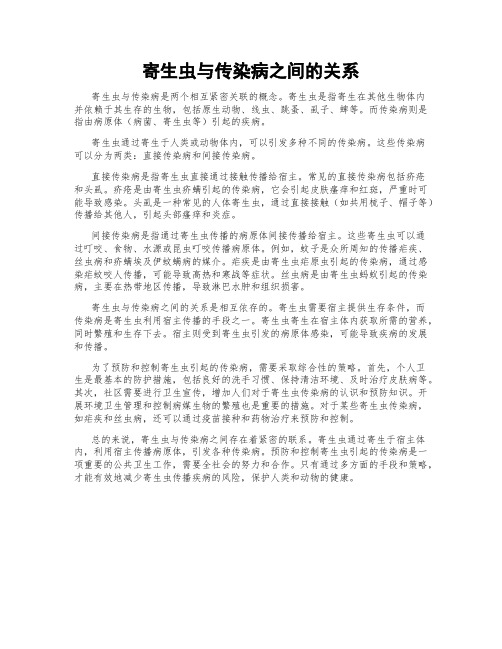
寄生虫与传染病之间的关系寄生虫与传染病是两个相互紧密关联的概念。
寄生虫是指寄生在其他生物体内并依赖于其生存的生物,包括原生动物、线虫、跳蚤、虱子、蜱等。
而传染病则是指由病原体(病菌、寄生虫等)引起的疾病。
寄生虫通过寄生于人类或动物体内,可以引发多种不同的传染病。
这些传染病可以分为两类:直接传染病和间接传染病。
直接传染病是指寄生虫直接通过接触传播给宿主。
常见的直接传染病包括疥疮和头虱。
疥疮是由寄生虫疥螨引起的传染病,它会引起皮肤瘙痒和红斑,严重时可能导致感染。
头虱是一种常见的人体寄生虫,通过直接接触(如共用梳子、帽子等)传播给其他人,引起头部瘙痒和炎症。
间接传染病是指通过寄生虫传播的病原体间接传播给宿主。
这些寄生虫可以通过叮咬、食物、水源或昆虫叮咬传播病原体。
例如,蚊子是众所周知的传播疟疾、丝虫病和疥螨埃及伊蚊螨病的媒介。
疟疾是由寄生虫疟原虫引起的传染病,通过感染疟蚊咬人传播,可能导致高热和寒战等症状。
丝虫病是由寄生虫蚂蚁引起的传染病,主要在热带地区传播,导致淋巴水肿和组织损害。
寄生虫与传染病之间的关系是相互依存的。
寄生虫需要宿主提供生存条件,而传染病是寄生虫利用宿主传播的手段之一。
寄生虫寄生在宿主体内获取所需的营养,同时繁殖和生存下去。
宿主则受到寄生虫引发的病原体感染,可能导致疾病的发展和传播。
为了预防和控制寄生虫引起的传染病,需要采取综合性的策略。
首先,个人卫生是最基本的防护措施,包括良好的洗手习惯、保持清洁环境、及时治疗皮肤病等。
其次,社区需要进行卫生宣传,增加人们对于寄生虫传染病的认识和预防知识。
开展环境卫生管理和控制病媒生物的繁殖也是重要的措施。
对于某些寄生虫传染病,如疟疾和丝虫病,还可以通过疫苗接种和药物治疗来预防和控制。
总的来说,寄生虫与传染病之间存在着紧密的联系。
寄生虫通过寄生于宿主体内,利用宿主传播病原体,引发各种传染病。
预防和控制寄生虫引起的传染病是一项重要的公共卫生工作,需要全社会的努力和合作。
-考研-西医综合-章节练习-病理学-(十四)传染病及寄生虫病(共33题)
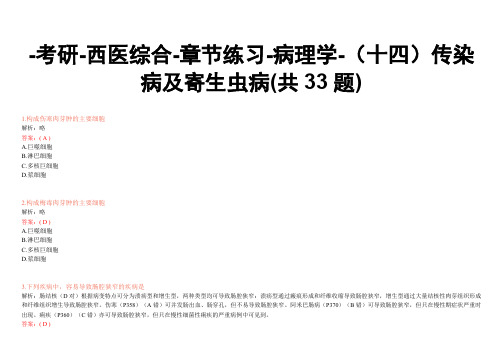
-考研-西医综合-章节练习-病理学-(十四)传染病及寄生虫病(共33题)1.构成伤寒肉芽肿的主要细胞解析:略答案:( A )A.巨噬细胞B.淋巴细胞C.多核巨细胞D.浆细胞2.构成梅毒肉芽肿的主要细胞解析:略答案:( D )A.巨噬细胞B.淋巴细胞C.多核巨细胞D.浆细胞3.下列疾病中,容易导致肠腔狭窄的疾病是解析:肠结核(D对)根据病变特点可分为溃疡型和增生型,两种类型均可导致肠腔狭窄:溃疡型通过瘢痕形成和纤维收缩导致肠腔狭窄,增生型通过大量结核性肉芽组织形成和纤维组织增生导致肠腔狭窄。
伤寒(P358)(A错)可并发肠出血、肠穿孔,但不易导致肠腔狭窄。
阿米巴肠病(P370)(B错)可导致肠腔狭窄,但只在慢性期症状严重时出现。
痢疾(P360)(C错)亦可导致肠腔狭窄,但只在慢性细菌性痢疾的严重病例中可见到。
A. 伤寒B.阿米巴肠病C.痢疾D.肠结核4.梅毒性增生性动脉内膜炎时,血管周围浸润的特征性炎细胞是解析:梅毒累及小动脉时,小动脉周围出现大量单核细胞、淋巴细胞和浆细胞浸润,称为小动脉周围炎;随着病情的发展,小动脉内皮细胞及纤维细胞增生,使管壁增厚、血管腔狭窄闭塞,发展成增生性动脉内膜炎(闭塞性动脉内膜炎)。
浆细胞(B对)恒定出现在血管周围是小动脉周围炎和增生性动脉内膜炎的病变特点。
答案:( B )A.巨噬细胞B.浆细胞C.T淋巴细胞D.中性粒细胞5.HIV病毒可以感染的人体细胞有解析:艾滋病(AIDS)是由HIV(人类免疫缺陷病毒)感染所引起的:①HIV可以感染CD4⁺T淋巴细胞(A对),而不是B淋巴细胞(B错)。
②HIV可以感染巨噬细胞(C 对)。
③HIV可以感染树突状细胞(D对),并使其成为HIV的“储备池”。
答案:( ACD )A.T淋巴细胞B.B淋巴细胞C.巨噬细胞D.树突状细胞6.原发性肺结核的好发部位是解析:原发性肺结核的病灶好发于肺上叶下部或下叶上部(D对)。
肺尖部(A错)和肺锁骨下区(B错)均为继发性肺结核的好发部位。
病理学-寄生虫病

丝虫病的病理特点
症状
丝虫病的症状主要包括淋巴结肿大、发热、四肢酸痛、皮疹和睾丸肿痛等。丝虫 病可引起淋巴管炎和淋巴结炎,导致淋巴管阻塞和淋巴回流障碍。
病理过程
丝虫成虫寄生于淋巴管内,产卵后随淋巴液进入淋巴结,引起淋巴结炎和淋巴管 炎。丝虫的代谢产物可引起局部过敏反应和炎症反应,导致相应的症状。丝虫病 还可能引起全身性病变,如丝虫热、丝虫性心包炎和丝虫性脑膜炎等。
并发症
寄生虫病可引起多种并发 症,如感染性休克、器官 功能衰竭等。
疾病负担
寄生虫病在贫困地区和低 收入人群中更为常见,给 患者和社会带来沉重的疾 病负担。Biblioteka 02常见寄生虫病的病理特点
疟疾的病理特点
症状
疟疾的症状包括寒战、高热、大量出汗和贫血等。这些症状通常会周期性地出 现,与红细胞内疟原虫的生命周期有关。
行诊断。
寄生虫病的治疗方法
01
02
03
04
药物治疗
根据不同寄生虫种类选择合适 的药物进行治疗,如抗蠕虫药
、抗吸虫药等。
手术治疗
对于某些寄生虫病,如囊尾蚴 病、棘球蚴病等,需要手术摘
除病灶。
支持治疗
对于严重感染或并发症的患者 ,需要进行支持治疗,如输血
、补液等。
联合治疗
对于一些复杂的寄生虫病,可 能需要联合多种治疗方法进行
病理过程
疟原虫在红细胞内寄生并繁殖,导致红细胞破裂,引发炎症反应和免疫应答。 疟疾的严重程度和病程长短取决于感染的疟原虫种类和数量,以及个体的免疫 反应。
阿米巴病的病理特点
症状
阿米巴病的症状主要包括腹痛、腹泻 、发热和体重减轻等。阿米巴病可以 引起肠道炎症和溃疡,导致消化道出 血和穿孔。
《病理学与病理生理学》课程标准精选全文
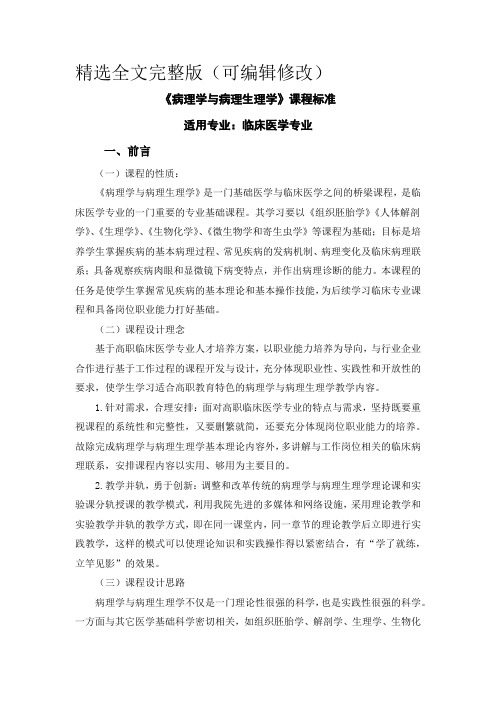
精选全文完整版(可编辑修改)《病理学与病理生理学》课程标准适用专业:临床医学专业一、前言(一)课程的性质:《病理学与病理生理学》是一门基础医学与临床医学之间的桥梁课程,是临床医学专业的一门重要的专业基础课程。
其学习要以《组织胚胎学》《人体解剖学》、《生理学》、《生物化学》、《微生物学和寄生虫学》等课程为基础;目标是培养学生掌握疾病的基本病理过程、常见疾病的发病机制、病理变化及临床病理联系;具备观察疾病肉眼和显微镜下病变特点,并作出病理诊断的能力。
本课程的任务是使学生掌握常见疾病的基本理论和基本操作技能,为后续学习临床专业课程和具备岗位职业能力打好基础。
(二)课程设计理念基于高职临床医学专业人才培养方案,以职业能力培养为导向,与行业企业合作进行基于工作过程的课程开发与设计,充分体现职业性、实践性和开放性的要求,使学生学习适合高职教育特色的病理学与病理生理学教学内容。
1.针对需求,合理安排:面对高职临床医学专业的特点与需求,坚持既要重视课程的系统性和完整性,又要删繁就简,还要充分体现岗位职业能力的培养。
故除完成病理学与病理生理学基本理论内容外,多讲解与工作岗位相关的临床病理联系,安排课程内容以实用、够用为主要目的。
2.教学并轨,勇于创新:调整和改革传统的病理学与病理生理学理论课和实验课分轨授课的教学模式,利用我院先进的多媒体和网络设施,采用理论教学和实验教学并轨的教学方式,即在同一课堂内,同一章节的理论教学后立即进行实践教学,这样的模式可以使理论知识和实践操作得以紧密结合,有“学了就练,立竿见影”的效果。
(三)课程设计思路病理学与病理生理学不仅是一门理论性很强的科学,也是实践性很强的科学。
一方面与其它医学基础科学密切相关,如组织胚胎学、解剖学、生理学、生物化学、微生物学和寄生虫学等,这些学科主要研究正常人体的形态结构和功能代谢,为病理学与病理生理学研究疾病时机体形态结构和功能代谢变化提供理论基础,是学好病理学与病理生理学的前提;另一方面与临床各科实际工作亦有十分密切的联系,是学习临床专业课程的重要桥梁学科。
病理学

病理学:研究患病机体的机能、代谢和形态结构的变化,从而探讨患病畜禽的生命活动规律的一门学科疾病:机体与外界致病因素相互作用产生的损伤与抗损伤的复杂争斗过程,并表现机体生命活动障碍,在畜禽并可以导致其经济价值降低疾病的分类、1按发病原因传染病:指病原微生物侵入机体,并在体内进行生长、繁殖而引起具有传染性疾病(猪瘟、新城疫、炭疽)寄生虫病:由寄生虫侵入机体而引起的疾病(蛔虫病)普通病:一般性致病因素引起的内、外、产科疾病(外伤、难产、肠胃炎)2按疾病的经过急性病、慢性病3按患病器官:消化系统、呼吸、泌尿、营养、运动病程:潜伏期、前驱期、明显期、转归期完全痊愈:患畜由病理调节转为生理调节,疾病症状全部消失,受损器官的机能形态结构、生产力和经济价值也彻底恢复不完全痊愈:主要症状消失,机能未完全恢复,遗留疾病残迹死亡:机体破坏后,不适应生长环境,最后呼吸和心跳停止。
有病理性死亡和生理性死亡疾病发生的外因:生物性,特点:致病性具有选择性有严格传染途径和作用部位;致病作用由致病因素产生的毒性物质和机体抵抗力感染性决定;具有特异性;作用整个疾病过程具有传染性化学性,特点:短暂潜伏期;对机体毒害作用有选择性;作用结果取决于性质、结构、剂量、排毒物理性:特点:对组织没有选择性;无潜伏期及前驱期或很短;只能引起发生不参加进一步发展;转归方式病理状态营养性:特点管理不当;饲料营养物质不均衡内因:感受性和抵抗力代偿:在疾病过程中,一些器官组织的形态结构受到破坏或机能发生障碍时,体内另外一些组织器官加强机能以适应新的条件的现象肥大:代偿过程中某些器官或组织细胞体积变大或数量增多,使组织或器官体积增大。
是代偿的表现形式之一修复:机体以各种补偿性生长,使受损的组织或器官恢复原来的机能,使死亡的细胞由新生细胞来补充的过程再生:机体细胞或部分死亡消失后,由其残留部分生长出新的组织、细胞,以恢复原来的组织结构和机能的现象动脉性充血(亦称潮红):在某些致病因素的影响下,局部组织或器官的小动脉及毛细血管发生扩张,流入血量增多,引起组织或器官内血量增多静脉性充血(淤血或发绀):局部组织或器官内,动脉输入血液量正常,而静脉回流受阻,引起静脉内血液量增多原因1静脉受压;2静脉阻塞;3静脉管壁舒缩机能障碍。
- 1、下载文档前请自行甄别文档内容的完整性,平台不提供额外的编辑、内容补充、找答案等附加服务。
- 2、"仅部分预览"的文档,不可在线预览部分如存在完整性等问题,可反馈申请退款(可完整预览的文档不适用该条件!)。
- 3、如文档侵犯您的权益,请联系客服反馈,我们会尽快为您处理(人工客服工作时间:9:00-18:30)。
Sexually Transmitted Disease, STD
In the past decade, the spectrum of sexually transmitted disease (STD) has widened considerably
Syphilis (Lues)
An important STD Multiple clinical presentations (thus designated the
Tuberculoid leprosy
Peripheral neuropathy: rigid and swollen nerves
From small dermal nerves to nerve trunk N. auricularis magnus (耳大),
N. auricularis posterior(耳后)
leonine faces hypoesthetic or anesthetic
Lepromatous leprosy
LM:Skin lesions:
large amounts of lepra cells and a few lymphcytes infiltration enclose vessels and appendages Clear line (grenz zone )
• susceptible population
3. Pathogenesis
•
entry cell
•
toxin /enzyme, vessel injury
•
immune response
Leprosy (麻风)
Introduction
History
Epidemiology Harm
Etiology
Lepromatous leprosy
Peripheral nerves:ulnar and peroneal nerves
Symmetrically invaded with mycobacteria, with minimal inflammation
Loss of sensation and trophic changes. Lymph nodes: foamy histiocytes in the paracortical areas, with
Lack CD4+ TH1 cells at the margins but instead contain many CD8+ suppressor T cells
Lepromatous leprosy
Skin lesions:
Macular, papular, or nodular lesions form on the face, ears, back, extremites
Infectious diseases
Infectious Disease
Common Features
1. Etiology:
•
pathogenic microbes
•
parasites
2. Epidemiology
• source of infection
• route of transmission
Intact cellular immune response Slow course, spanning decades Limited lesions Few bacilli within the lesion
Mainly involve skin and nerves Clinical feature: lepromin test (+)
process Infectivity
Develop slowly Weak
Relative fast Strong
Sexually Transmitted Disease STD
Venereal Diseases, VD
five classic venereal diseases
Syphilis Gonorrhea chancroid granuloma inguinale lymphogranuloma venereum
Virulence is based on properties of its cell wall
✓ Human being seems to be the only victim
Transmission
Contained in secretion Respiratory pathway
Abrasion or wounds Taken up by macrophages disseminates through the blood
Lepromatous leprosy (20%)
anergic immunity lepromin test (-)
Large amouts of bacilli infectious Acute deteriorate, poor prognosis Generally involved the skin, peripheral nerves,
Types according to pathological changes
Tuberculoid leprosy Lepromatous leprosy Borderline leprosy Indeterminate leprosy
Tuberculoid leprosy (60-70%)
Tuberculoid type
70% Intense Macula or papula, tuberculoid, few bacilli (+) (+/-) Limited to skin and nerves
Lepromatous type
20% Subdued Protuberant, large amount of bacilli (-) (+++) Extend to other organs
Transmission
Mode:
sexual intercourse (>95%)
Acquired sypilis
transplacental transmission
Congenital sypilis
Pathogenesis
Traverse abraded skin and mucosa
Clinical course
Latant period: 2-4 years Cellular immunity Humoral immunity Lepromin test
Pathogenesis
A bipolar disease
tuberculoid leprosy (T-cell mediated immune response ) lepromatous leprosy (Immunity anergic)
low infectivity good prognosis
Tuberculoid leprosy
Granuloma similar to hard tubercles
1. epithelioid macrophages 2. giant cells 3. without caseous necrosis 4. Peripheral: CD4+ Th1 IL-2 and IFN-γ 5. few surviving mycobacteria
Two morphologic patterns of tissue injury
1.
Obliterative endarteritis
2.
Gumma
Morphology
1. Obliterative endarteritis Perivascular inflammation
LM
Granulomatous inflammatory reactions
Fibrosis, absence of nerves
Tuberculoid leprosy
Clinical pathologic conference
Anesthesias, atrophy, contractures, paralysis, liable to trauma, autoamputation of fingers or toes,
Tuberculoid leprosy
Skin lesions
LM: tuberculoid granuloma
enclose blood vessles , cutaneous appendages and nerves extend to the basal cells of epidermis
Tuberculoid leprosy
Skin lesions: macula or papula
gross: flat and red
irregular shapes with
indurated, elevated, hyperpigmented margins and
depressed pale centers
anterior eye, upper airways, testes, lymph node, viscera
Lepromatous leprosy
large aggregates of lipid laden macrophages (lepra cells), often filled with masses of acid-fast bacilli
Enter lymph circulation
Travel through blood and reach various organs and tissue
